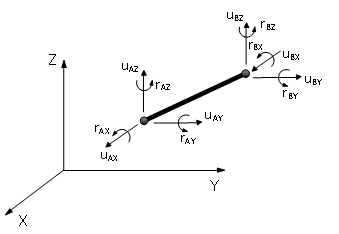Distributed mass - dmass
The user needs only to specify the unitary mass (mass/length) value, from which the program computes internally the total element mass M, and subsequently derives the respective diagonal mass matrix with reference to the global translational degrees-of-freedom of the member.

Notes
- When the structure is subjected to very large deformations (e.g. buckling), the employment of two or more dmass elements per member is recommended, for accurate modelling.
- If the loads are derived from masses (in the gravity direction based on the g value or in any translational direction, according to user-defined coefficients), then the program will automatically compute and apply ''distributed permanent loads'', herein effectively consisting of equivalent point forces/moments applied at the end nodes of the element (stress recovery will not have any effect in this case).
- Distributed loads obtained from dmass elements are not considered in stress-recovery operations (because they are separate elements from the beams/columns), hence moment values throughout an element's length are bound to be wrong. Users interested in obtaining correct moments throughout an element's length, should define distributed mass/load using the 'material volumetric weight' in the Materials module and/or 'section added mass' in the Sections module.